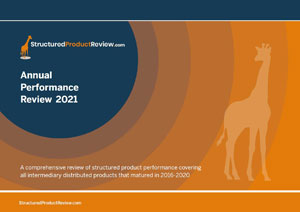16/09/2021
Josh Mayne, Lowes Financial Management
Last week IDAD released two structured deposits into the retail space – IDAD The Callable Deposit Plan Issue 12 November 2021, and IDAD The Enhanced Callable Deposit Plan Issue 2 November 2021. The former protects capital in full and offers clients 60% participation, uncapped, in the FTSE 100 Index at maturity, and the latter offers 150% participation, uncapped – but there’s a price to pay for this.
With both plans, the Deposit Taker (Goldman Sachs International) has the right to terminate the deposit on any quarterly observation date from the second anniversary onwards when they will compensate with an interest payment of 5% or 7.5% respectively per it has been in force. It is worth noting that we believe an early termination in this manner is highly unlikely, and it is the end participation that investors should base their investment decision on.
Structured deposits effectively take the interest that would otherwise be earned on a fixed term deposit over the term and swap it for equity market exposure. As an example, a structured deposit we ‘preferred’ five years ago offered a 34% gain if the FTSE 100 was higher at the end of six years. This commenced in 2016 when Bank of England Base Rate stood at half a percent and so the deposit involved giving up not a lot of potential interest that would have been received from a standard or fixed term deposit account and potentially returning an equivalent compound annual rate of almost 5%. Worth the risk we thought. As it happens, with ten months to go, the FTSE 100 stands at more than 1000 points higher than where it needs to be to trigger the 34% interest payment.
As we all know, interest rates have come down further thanks, in part, to the pandemic and now money on deposit can expect to earn very little, as opposed to not a lot. So how much equity market exposure does very little interest buy you nowadays? The answer is ‘not a lot’. Sixty percent over seven years, in the case of Issue 12 of IDAD’s latest offer. Whist the terms aren’t quite identical, for this structured deposit to provide the same return at the end of its term, as our example above, maturing next year the FTSE 100 would need to be more than 56% higher. In fact, it would need to be more than 15% higher just to beat the guaranteed return that could be achieved from fixed term deposits. So, what’s the alternative?
Well obviously, putting capital at risk enhances potential returns and if you’re optimistic enough to expect a 56% rise in the stock market over the next six years then you’re no doubt taking on the risk. But in the deposit space which offers the surety of capital choices are thin.
IDAD’s latest innovation, The Enhanced Callable Deposit Plan, has sought to bridge the gap but raised more than a few eyebrows in our office. This plan has a nuance whereby the clients are guaranteed to lose 5% of their initial capital if the FTSE doesn’t rise – a 5% ‘Initial Payment’ is taken from the initial investment, and so 95% (the net deposit amount) is actually deposited.
FVC’s analysis of the product indicates that 32.91% of back tested simulations resulted in capital loss and under their simulated probability assessment this percentage rises to 45.59% (FCV).
The ‘enhanced’ deposit is guaranteed to lose 5% of investor’s capital in flat or falling markets, however the basic principle of a structured deposit has always been that no matter what, you are assured the full return of your capital if left until maturity. Even if the bank defaults, deposit capital is FSCS protected up to £85k. So, a deposit that could return less than invested capital, and ultimately puts capital at risk, doesn’t sit well with us.
That said, the literature does not seek to hide the 5% cost and implications of it and we recognise that with interest rates were they are, there is very little to play with and IDAD have simply tried to innovate to meet demand in very difficult market circumstances. We hope that the ultimate outcome is a positive one – outperforming fixed term deposits.
Also in this section
- Q3 2024 Issuance
- Q3 2024 maturity results
- A share of spread bets on steroids?
- Product focus - September 2024
- Maturities of the month - August 2024
- Right on time
- Product focus - August 2024
- Keep calm and zoom out
- 2,000 and counting
- Q2 2024 maturity results
- 20 years of autocall maturities
- Product focus - June 2024
- Fixed income or interest?
- Maturities of the month - May 2024
- The barrier debate - revisited
- Product focus - April 2024
- Maturities of the month - April 2024
- Time to call
- I don't believe markets are ever too high for Structured products!
- Notes on counterparty exposure
- Return of Nikkei
- Q1 2024 issuance
- Q1 2024 maturity results
- Structured Products – AAAAAGH!
- Hop in CIBC
- Re-enter Santander
- How to build a financial fortune - revisited
- Issuance in 2023
- Where's the risk?
- Questionable offerings
- Challenging the case against structured products - 'Loss of dividends'
- Navigating the investment landscape
- Challenging the case against structured products - Counterparty risk
- 6-year autocalls approaching final destination
- 1,750 FTSE capital at risk autocall maturities
- The leopard that changed her spots
- Q3 2023
- Challenging the case against structured products - Keydata
- Dilemmas for UK IFA's and the unique role of Structured Products
- 'High charges'
- Precipice bonds
- Intro
- FTSE 100 Contingent Income
- Indexing the indices
- Something different
- Investing through volatility
- 100 10:10s
- The best or worst?
- The 10%/25% 'Rule' that never was
- Structured products and the yield curve
- Fixed income: Capital at risk?
- Prospects for UK inflation - and fun with A.I!
- The Barrier Debate
- More Deposits for now
- Last of the Americans
- What if?
- Time heals all wounds, we hope...
- How to diversify portfolios using structured products?
- The Proof Is In The Pudding...
- Debunking Structured Misconceptions
- 1,500 FTSE Capital-at-Risk Autocall Maturities
- Q3 2022 Maturity Results
- What do we prefer?
- Deposits vs Capital ‘Protected’
- There’s time yet…
- Where did you invest your clients?
- A Six-Month Reflection
- Return of the Rev Con
- Happy 2nd Birthday FTSE CSDI
- Q2 2022 Maturity Results
- The best and worst yet still the best
- Critique my Suitability - Mariana 10:10 Plan June 2022 (Option 2)
- 10/10 for 55 10:10’s
- Q1 2022 Maturity Results
- 'How to build a financial fortune': a follow up
- Critique my Suitability - Mariana 10:10 Plan April 2022 (Option 2)
- 2021 Capital-at-Risk Autocall Maturity Review
- An unwelcome return...
- CSDI's First Birthday
- Bon Anniversaire
- Introducing the FTSE Custom 100 Synthetic 3.5% Fixed Dividend Index
- Q3 2021 Maturity Results
- Critique my Suitability - Mariana 10:10 Plan October 2021 (Option 2)
- Blurring the lines...
- Beware of false knowledge; it is more dangerous than ignorance
- Good news, bad news...
- Certainty is Certainly a Benefit
- Critique my Suitability - Mariana 10:10 Plan September 2021 (Option 2)
- A Twenty-Year Progression
- Q2 2021 Maturity Results
- Nine 8:8s Post Positive Returns in Falling Markets
- Critique my Suitability
- Q1 2021 Maturity Results
- Morgan Stanley’s Marvelous Maturity Medley
Current Products
We review the UK's retail structured investment sector, providing pertinent support for Professional Advisers and relevant research tools.
View all ⟶


